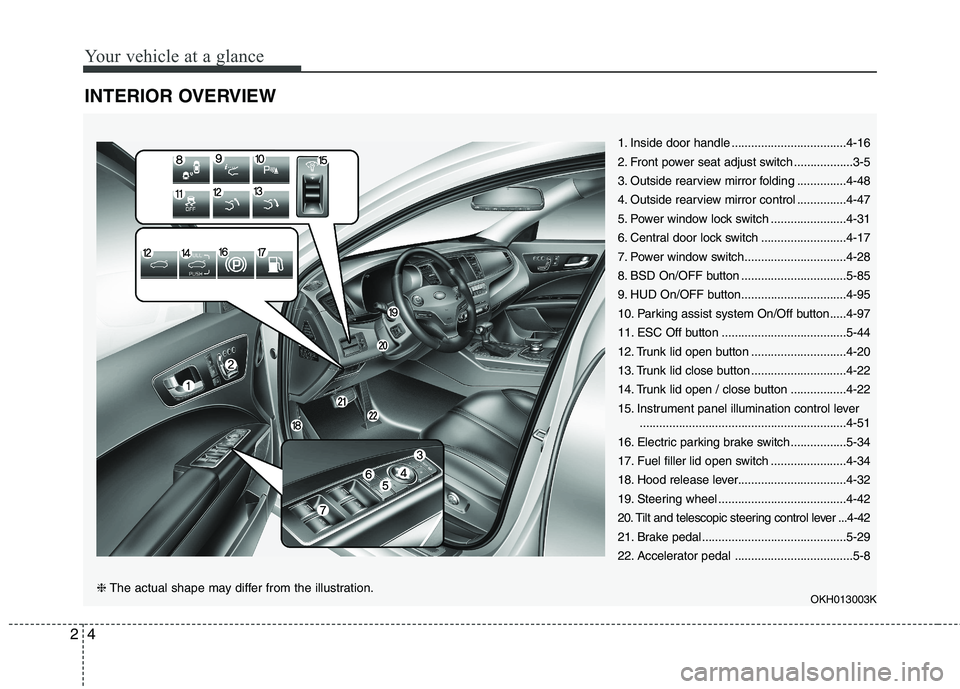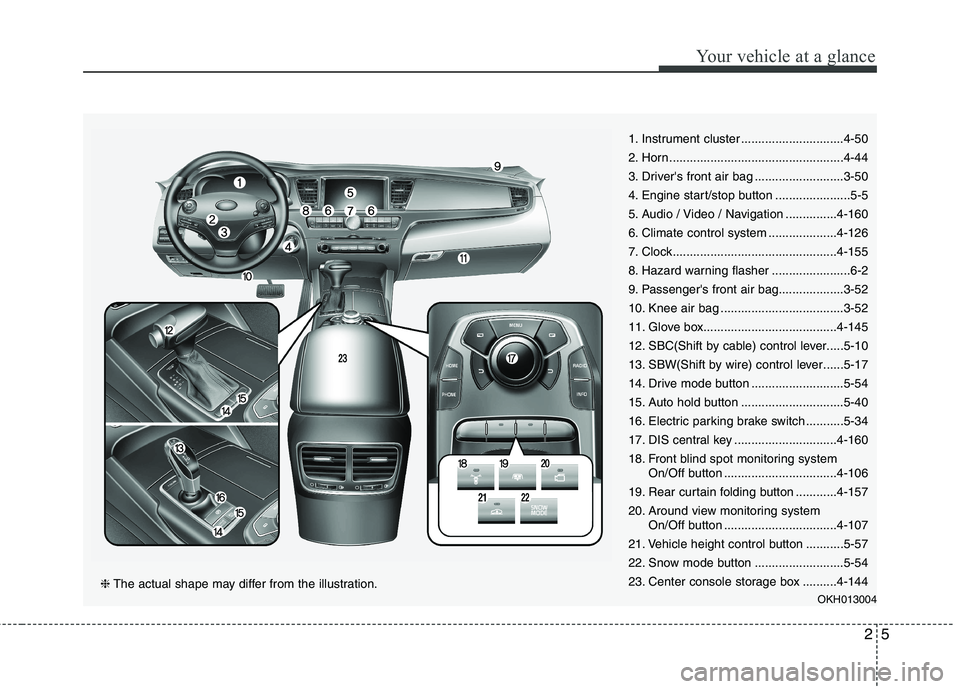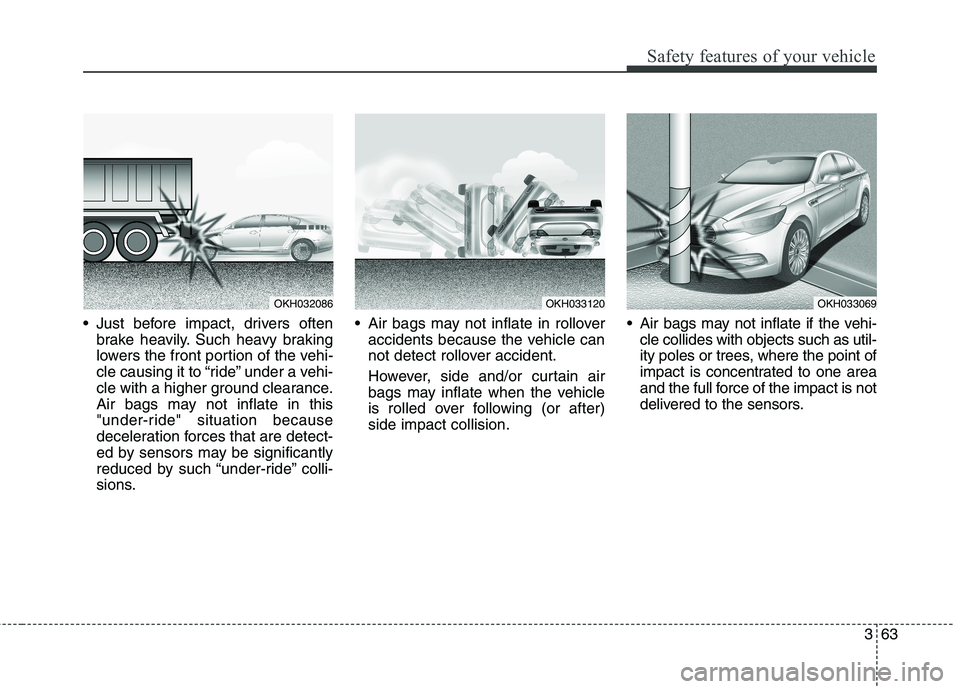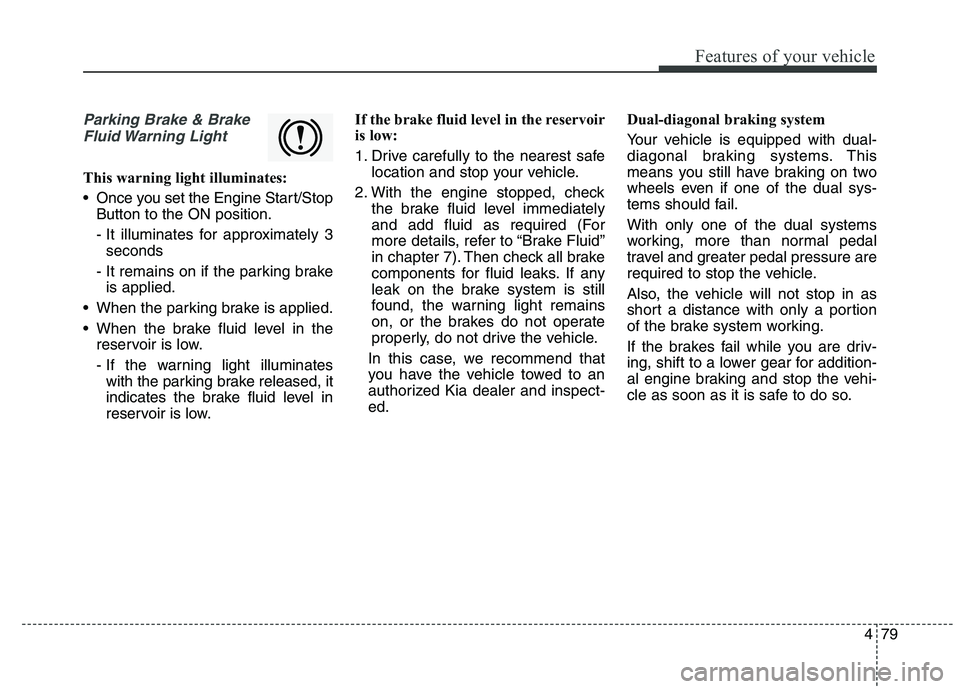brake KIA QUORIS 2015 Owners Manual
[x] Cancel search | Manufacturer: KIA, Model Year: 2015, Model line: QUORIS, Model: KIA QUORIS 2015Pages: 486, PDF Size: 35.55 MB
Page 8 of 486

15
Introduction
No special break-in period is needed.
By following a few simple precautions
for the first 1,000 km (600 miles) you
may add to the performance, econo-
my and life of your vehicle.
Do not race the engine.
While driving, keep your enginespeed (rpm, or revolutions per
minute) between 2,000 rpm and
4,000 rpm.
Do not maintain a single speed for long periods of time, either fast or
slow. Varying engine speed is
needed to properly break-in the
engine.
Avoid hard stops, except in emer- gencies, to allow the brakes to seat
properly.
VEHICLE BREAK-IN PROCESS
Page 12 of 486

Your vehicle at a glance
4
2
INTERIOR OVERVIEW
1. Inside door handle ...................................4-16
2. Front power seat adjust switch ..................3-5
3. Outside rearview mirror folding ...............4-48
4. Outside rearview mirror control ...............4-47
5. Power window lock switch .......................4-31
6. Central door lock switch ..........................4-17
7. Power window switch...............................4-28
8. BSD On/OFF button ................................5-85
9. HUD On/OFF button................................4-95
10. Parking assist system On/Off button.....4-97
11. ESC Off button ......................................5-44
12. Trunk lid open button .............................4-20
13. Trunk lid close button .............................4-22
14. Trunk lid open / close button .................4-22
15. Instrument panel illumination control lever
...............................................................4-51
16. Electric parking brake switch .................5-34
17. Fuel filler lid open switch .......................4-34
18. Hood release lever.................................4-32
19. Steering wheel .......................................4-42
20. Tilt and telescopic steering control lever ...4-42
21. Brake pedal............................................5-29
22. Accelerator pedal ....................................5-8
OKH013003K
❈The actual shape may differ from the illustration.
Page 13 of 486

25
Your vehicle at a glance
1. Instrument cluster ..............................4-50
2. Horn...................................................4-44
3. Driver's front air bag ..........................3-50
4. Engine start/stop button ......................5-5
5. Audio / Video / Navigation ...............4-160
6. Climate control system ....................4-126
7. Clock................................................4-155
8. Hazard warning flasher .......................6-2
9. Passenger's front air bag...................3-52
10. Knee air bag ....................................3-52
11. Glove box.......................................4-145
12. SBC(Shift by cable) control lever.....5-10
13. SBW(Shift by wire) control lever......5-17
14. Drive mode button ...........................5-54
15. Auto hold button ..............................5-40
16. Electric parking brake switch ...........5-34
17. DIS central key ..............................4-160
18. Front blind spot monitoring systemOn/Off button .................................4-106
19. Rear curtain folding button ............4-157
20. Around view monitoring system On/Off button .................................4-107
21. Vehicle height control button ...........5-57
22. Snow mode button ..........................5-54
23. Center console storage box ..........4-144 OKH013004
❈The actual shape may differ from the illustration.
Page 15 of 486

27
Your vehicle at a glance
ENGINE COMPARTMENT
1. Engine oil dipstick ............................7-24
2. Engine oil filler cap ..........................7-24
3. Engine coolant reservoir ..................7-26
4. Radiator cap ....................................7-26
5. Brake fluid reservoir.........................7-29
6. Power steering fluid reservoir ..........7-30
7. Windshield washer fluid reservoir ....7-31
8. Air cleaner .......................................7-32
9. Fuse box ..........................................7-54
10. Jumper terminal ...............................6-5
OKH012007
❈
The actual engine compartment in the vehicle may differ from the illustration.
❈ The battery is in the trunk.
Page 78 of 486

363
Safety features of your vehicle
Just before impact, drivers oftenbrake heavily. Such heavy braking
lowers the front portion of the vehi-
cle causing it to “ride” under a vehi-
cle with a higher ground clearance.
Air bags may not inflate in this
"under-ride" situation because
deceleration forces that are detect-
ed by sensors may be significantly
reduced by such “under-ride” colli-
sions. Air bags may not inflate in rollover
accidents because the vehicle can
not detect rollover accident.
However, side and/or curtain air
bags may inflate when the vehicle
is rolled over following (or after)side impact collision. Air bags may not inflate if the vehi-
cle collides with objects such as util-
ity poles or trees, where the point of
impact is concentrated to one area
and the full force of the impact is not
delivered to the sensors.
OKH032086OKH033120OKH033069
Page 99 of 486

Features of your vehicle
18
4
Door lock/unlock features
Impact sensing door unlock sys-
tem
All doors will automatically unlock when an impact causes the air bags
to deploy.
Speed sensing door lock system
All doors will automatically lock after
the vehicle speed exceeds 15 km/h.
WARNING - Unlocked
vehicles
Leaving your vehicle unlocked
can invite theft or possible harm
to you or others from someone
hiding in your vehicle while you
are gone. Always press the
engine start/stop button to the
OFF position, engage the park-
ing brake, close all windows
and lock all doors when leaving
your vehicle unattended.
WARNING - Unattended
children
An enclosed vehicle can become
extremely hot, causing death or
severe injury to unattended chil-dren or animals who cannot
escape the vehicle. Furthermore,
children might operate features
of the vehicle that could injure
them, or they could encounter
other harm, possibly from some-
one gaining entry to the vehicle.
Never leave children or animals
unattended in your vehicle.
WARNING - Doors
The doors should always be fully closed and locked while
the vehicle is in motion to pre-vent accidental opening of the
door. Locked doors will also
discourage potential intruders
when the vehicle stops or
slows.
Be careful when opening doors and watch for vehicles,
motorcycles, bicycles or
pedestrians approaching the
vehicle in the path of the door.Opening a door when some-
thing is approaching can
cause damage or injury.
Page 113 of 486

Features of your vehicle
32
4
Opening the hood
1. Pull the release lever to unlatch
the hood. The hood should pop
open slightly. 2. Go to the front of the vehicle, raise
the hood slightly, push the second-
ary latch (1) inside of the hoodcenter and lift the hood (2).
3. Raise the hood. It will raise com- pletely by itself after it has been
raised about halfway. Closing the hood
1. Before closing the hood, check the
following:
ment must be correctly installed.
bustible material must be
removed from the engine com-
partment.
2. Lower the hood halfway and push down to securely lock in place.
HOOD
OKH042028
OKH043029
WARNING
Before closing the hood, ensure that all obstructions
are removed from the hood
opening. Closing the hoodwith an obstruction present in
the hood opening may result
in property damage or severe
personal injury.
Do not leave gloves, rags or any other combustible materi-
al in the engine compartment.
Doing so may cause a heat-
induced fire.
WARNING
Open the hood after turning off
the engine on a flat surface,
shifting the shift lever to the
P(Park) position and setting the
parking brake.
Page 150 of 486

469
Features of your vehicle
Press brake pedal to start engine
This warning message illuminatesif the Engine Start/Stop Button
changes to the ACC position twice
by pressing the button repeatedly
without depressing the brake pedal.
It means that you should depress the brake pedal to start the engine.
Key not in vehicle
This warning message illuminatesif the smart key is not in the vehicle while the door is opened or closed
with the ignition switch in the ACC
position or engine is running.
It means that you should always have the smart key with you.
Key not detected
This warning message illuminatesif the smart key is not detected
when you press the Engine
Start/Stop Button.
OKH043422L
■Type A■Type B
OKH043417L
■ Type A■Type B
OKH043423L
■Type A■Type B
Page 151 of 486

Features of your vehicle
70
4
Press START button again
This warning message illuminates
if you can not operate the Engine
Start/Stop Button when there is a
problem with the Engine Start/StopButton system.
It means that you could start the engine by pressing the Engine
Start/ Stop Button once more.
If the warning illuminates each time you press the Engine Start/Stop
Button, we recommend that you
have the vehicle inspected by an
authorized Kia dealer.
Press START button with key
This warning message illuminatesif you press the Engine Start/Stop
Button while the warning message
“Key not detected” is illuminating.
At this time, the immobilizer indica- tor light blinks.
Check BRAKE SWITCH fuse
This warning message illuminatesif the brake switch fuse is discon- nected.
It means that you should replace the fuse with a new one. If that is
not possible, you can start the
engine by pressing the Engine
Start/Stop Button for 10 seconds in
the ACC position.
OKH043425L
■Type A■Type B
OKH043424L
■ Type A■Type B
OKH043426L
■Type A■Type B
Page 160 of 486

479
Features of your vehicle
Parking Brake & BrakeFluid Warning Light
This warning light illuminates:
Once you set the Engine Start/Stop Button to the ON position.
- It illuminates for approximately 3seconds
- It remains on if the parking brake is applied.
When the parking brake is applied.
When the brake fluid level in the reservoir is low.
- If the warning light illuminateswith the parking brake released, it
indicates the brake fluid level in
reservoir is low. If the brake fluid level in the reservoir
is low:
1. Drive carefully to the nearest safe
location and stop your vehicle.
2. With the engine stopped, check the brake fluid level immediately
and add fluid as required (For
more details, refer to “Brake Fluid”
in chapter 7). Then check all brake
components for fluid leaks. If any
leak on the brake system is still
found, the warning light remains
on, or the brakes do not operate
properly, do not drive the vehicle.
In this case, we recommend that
you have the vehicle towed to an
authorized Kia dealer and inspect-ed. Dual-diagonal braking system
Your vehicle is equipped with dual-
diagonal braking systems. This
means you still have braking on two
wheels even if one of the dual sys-
tems should fail. With only one of the dual systems
working, more than normal pedal
travel and greater pedal pressure are
required to stop the vehicle.
Also, the vehicle will not stop in as
short a distance with only a portion
of the brake system working.
If the brakes fail while you are driv-
ing, shift to a lower gear for addition-
al engine braking and stop the vehi-
cle as soon as it is safe to do so.